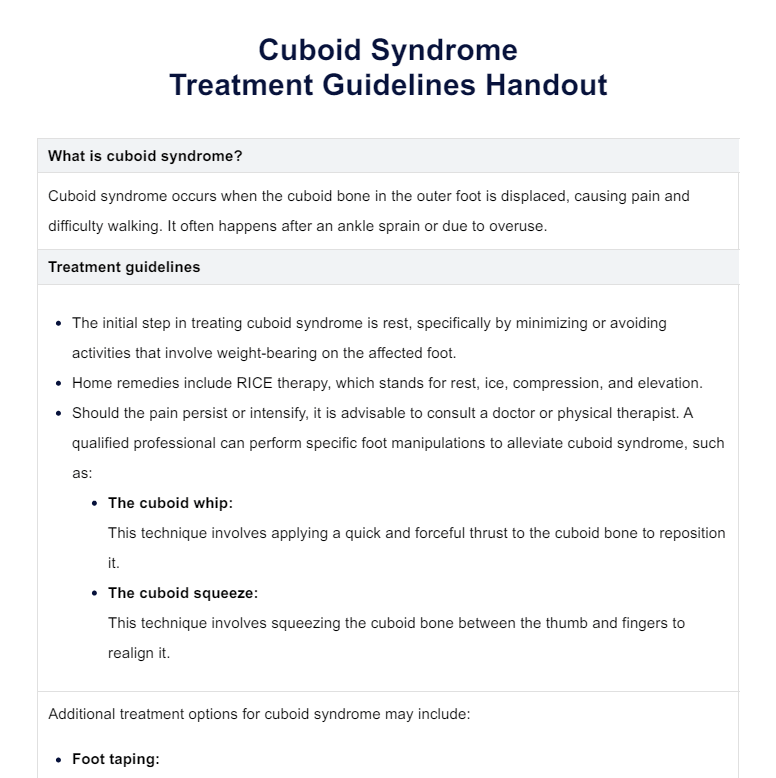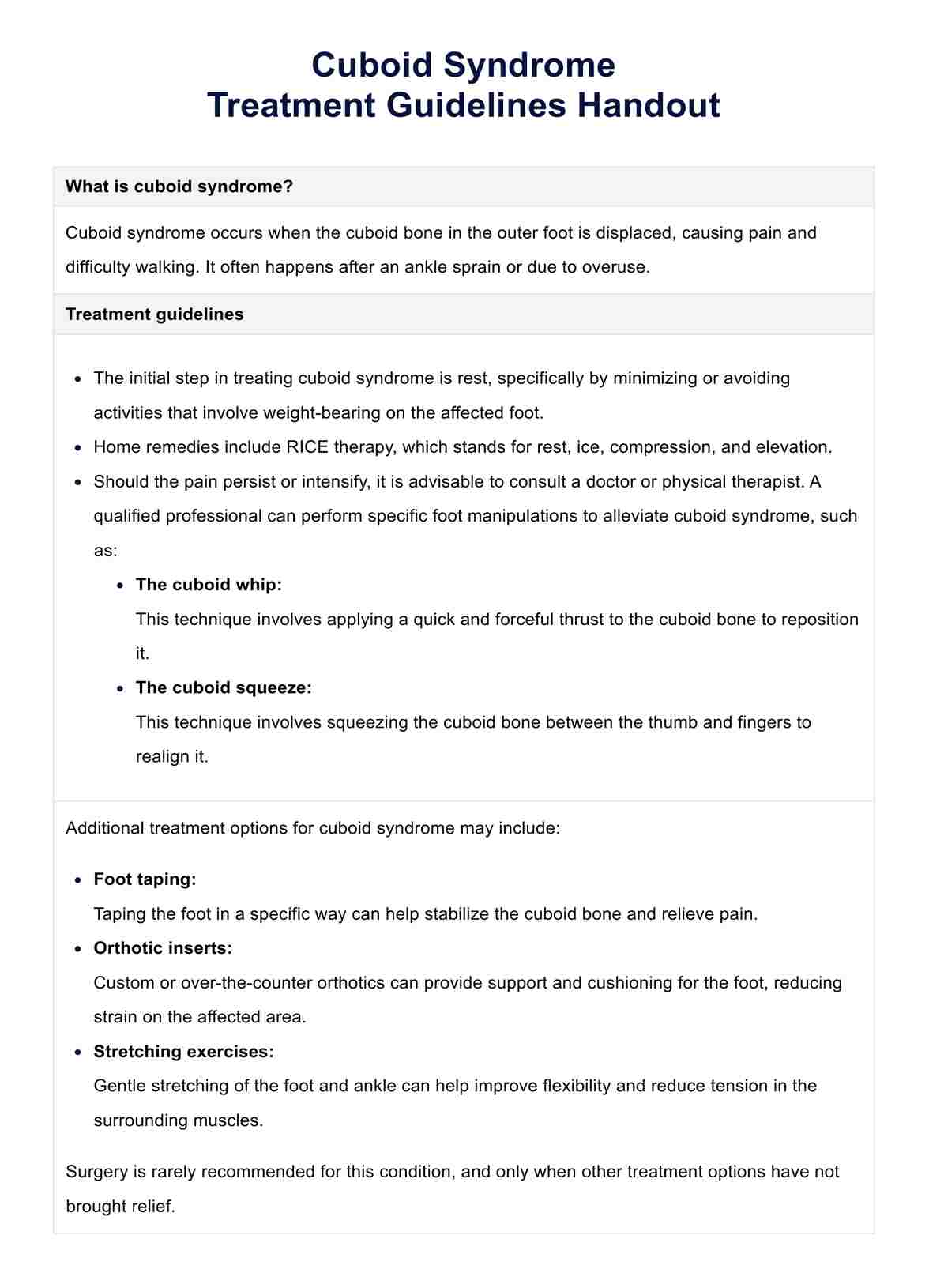Cuboid Syndrome Treatment Guidelines Handout
Use our Cuboid Syndrome Treatment Guidelines Handout to help manage Cuboid Syndrome and support your patients' recovery. Download the template and example now!


What is cuboid syndrome?
The cuboid bone is one of the seven small tarsal bones in the foot, located on the lateral front side of the foot (near the little toe). Cuboid syndrome occurs when the cuboid bone moves out of proper alignment, causing stress on the surrounding tissues and ligaments. Also known as subluxation of the midtarsal joint, cuboid syndrome happens when the cuboid bone misaligns with the adjacent calcaneus bone.
Cuboid syndrome in the lateral midfoot leads to pain and dysfunction due to the subluxation or displacement of the cuboid bone. Risk factors for this condition include:
- Ankle sprains, especially inversion injuries
- Overuse from repetitive activities like running or dancing
- Excessive pronation or flat feet
- Poorly fitting shoes or orthotics
- Obesity
Common symptoms are lateral foot pain, difficulty walking, swelling, and reduced range of motion.
Cuboid Syndrome Treatment Guidelines Handout Template
Cuboid Syndrome Treatment Guidelines Handout Example
How to manage and treat cuboid syndrome
Treatment for cuboid syndrome aims to realign the cuboid bone, reduce pain, and restore function. Key management strategies include:
Manual manipulation
A trained practitioner can perform specific manipulations, such as the cuboid whip or cuboid squeeze move, to properly align the cuboid bone. This often provides immediate pain relief.
Physical therapy
Physical therapy focuses on stretching tight muscles, strengthening the foot and ankle, and improving proprioception. Modalities like ice, ultrasound, and e-stim may also reduce pain and inflammation.
Taping and orthotics
Cuboid padding or low-dye taping can help support the cuboid in the short term. Custom orthotics are useful for addressing any biomechanical factors and preventing recurrence in the long term.
Activity modification
Initially, activities that aggravate symptoms should be limited. As pain subsides and function improves, a gradual return to sports and dancing can occur. Proper warm-up and training on even surfaces are advised.
What is a Cuboid Syndrome Treatment Guidelines Handout?
A Cuboid Syndrome Treatment Guidelines Handout is an educational resource that outlines the management plan for this condition. It typically includes:
- An overview of the condition
- Specific treatment recommendations
- An illustrated home exercise program
This handout can be used by physical therapists, chiropractors, podiatrists, and other healthcare professionals treating patients with cuboid syndrome. Providing this resource helps reinforce the treatment plan, encourages patient compliance, and empowers self-management.
How to use our treatment guidelines handout template
Here are steps on how to use the Cuboid Syndrome Treatment Guidelines Handout template effective and help support your patients' treatments:
Review with your patient
Review the handout with your patient in detail. Ideally, this should be done after the initial evaluation or treatment session. Go through each handout section, explaining what cuboid syndrome is, the anatomy involved, and common causes. Teach your patient how to perform their home exercise program, demonstrating each exercise and then having them perform it to ensure proper technique.
Provide the handout
After thoroughly reviewing the treatment guidelines with your patient, provide them with a copy of the handout. You can print a physical copy for them or send it electronically, whichever is more convenient. Stress the importance of following the treatment plan as outlined.
Follow up and update
At follow-up appointments, review your patient's response to the treatment plan. Assess their compliance with the home exercise program and any activity modifications. Evaluate their progress in terms of pain, range of motion, strength, and function.
Encourage feedback and questions
Throughout the treatment process, actively seek input from your patient on the treatment guidelines handout. Ask if they find the information clear, relevant, and understandable. Encourage them to provide feedback on the home exercise program - are the instructions simple to follow, the photos helpful, and the exercises manageable?
Benefits of using this handout
Providing a professional treatment guidelines handout offers several advantages:
Reinforces your treatment approach and recommendations
Providing patients with a written handout detailing the agreed-upon treatment plan reinforces the specific approach you are taking to manage their cuboid syndrome.
Gives patients a clear and accessible reference
A concise document summarizing the key points of cuboid syndrome management empowers patients to be active participants in their care. The handout is an easy-to-follow reference that they can consult between appointments to refresh their memory on exercise techniques, activity modifications, or other vital instructions.
Encourages self-management and compliance with the plan of care
When patients have a comprehensive yet user-friendly resource to guide their cuboid syndrome management, they are better equipped to take ownership of their condition. The treatment guidelines empower them with the knowledge and tools to make positive choices in their daily lives to support their recovery.
Commonly asked questions
Recovery time for cuboid syndrome varies depending on the severity of the cuboid subluxation and any coincident lateral ankle sprain. However, with proper treatment from a physical therapist, including manual techniques like the cuboid squeeze and physical therapy modalities, most patients see improvement in their foot pain within 1-2 weeks.
While cuboid syndrome is not always preventable, as it often occurs due to sudden ankle sprains or lateral ankle sprains, there are steps you can take to reduce your risk. Wearing supportive shoes that fit well and using orthotics if needed can help protect your feet and ankles from injury.
Surgery is rarely indicated for cuboid syndrome. The vast majority of cases are resolved with conservative care like manual manipulation and physical therapy.







































































































